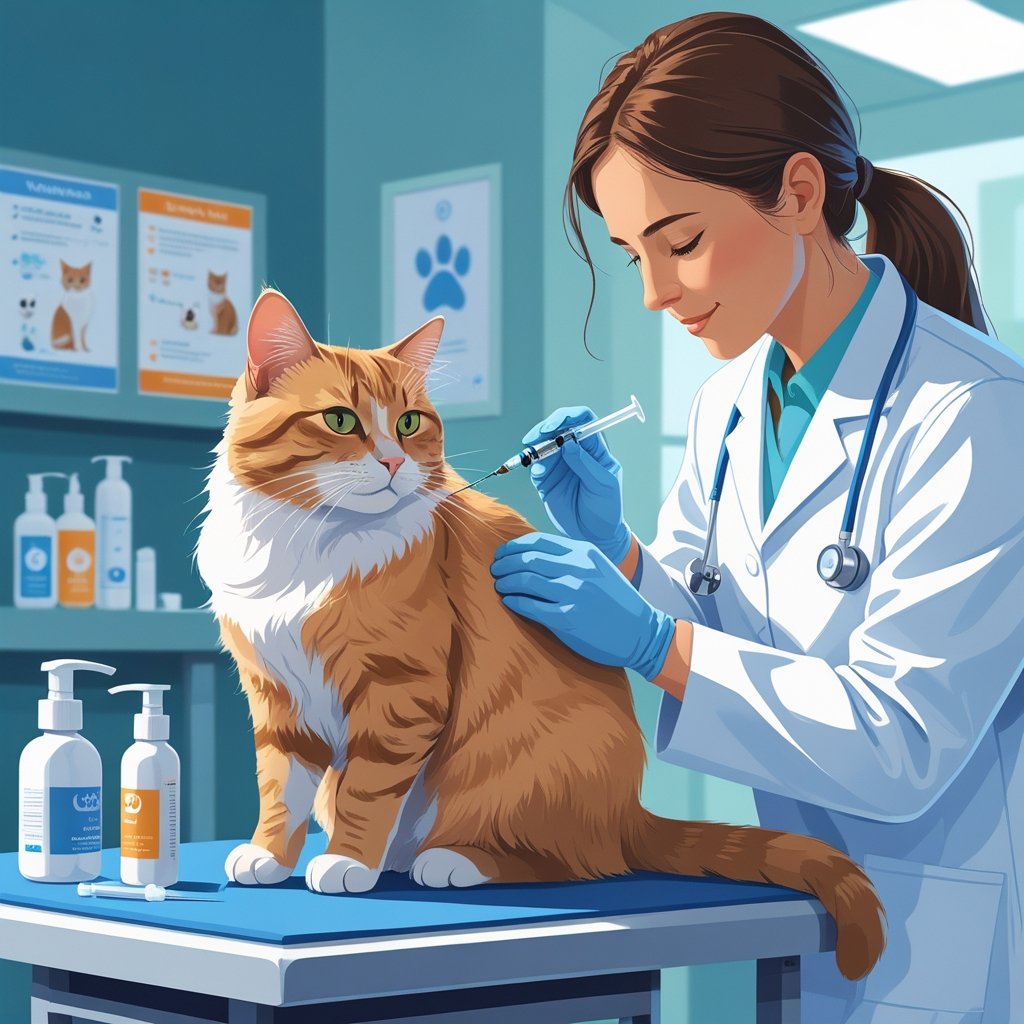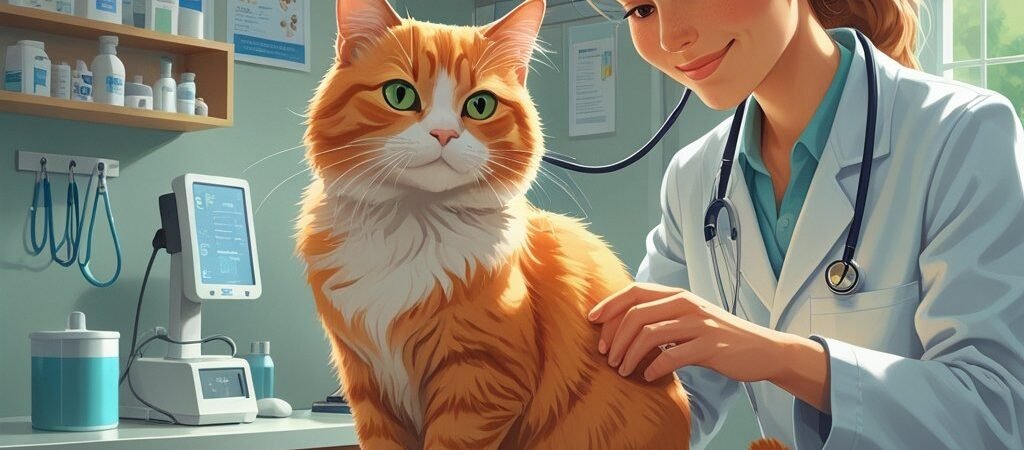Meta Description: Discover why regular vet checkups are crucial for cat health! Learn about preventive care, early disease detection, and how routine veterinary visits can save your cat’s life.
Regular veterinary checkups are one of the most important investments you can make in your cat’s health and longevity, yet they’re often overlooked until problems become obvious. Many cat owners mistakenly believe that because their feline friend seems healthy and stays indoors, veterinary visits are unnecessary. This dangerous misconception can lead to missed opportunities for early disease detection, preventive care, and health optimization that could literally save your cat’s life.
Cats are masters at hiding illness and discomfort – a survival instinct inherited from their wild ancestors who couldn’t afford to show weakness. By the time symptoms become visible to pet parents, diseases may have progressed to advanced stages where treatment is more difficult, expensive, and less likely to be successful. This makes routine veterinary examinations absolutely crucial for maintaining your cat’s health throughout their lifetime.
From detecting early signs of kidney disease and diabetes to monitoring dental health and updating vaccinations, regular vet visits provide comprehensive health assessments that keep minor issues from becoming major problems. Understanding the importance of preventive veterinary care, what to expect during checkups, and how to prepare for visits empowers you to be your cat’s best health advocate while potentially adding years to their life.
The Hidden Nature of Feline Illness

Understanding why cats conceal illness helps explain why regular veterinary examinations are so crucial for early detection and intervention.
Evolutionary Survival Instincts
Predator Avoidance: In the wild, showing signs of weakness or illness makes cats vulnerable to predators and competitors. This powerful survival instinct remains strong even in pampered house cats who face no such threats.
Resource Competition: Wild cats who appeared weak might lose access to territory, food sources, or mates. Hiding illness was literally a matter of survival and reproductive success.
Social Hierarchy: Even in multi-cat households, cats may hide illness to maintain their position in the social structure and avoid being perceived as vulnerable by other cats.
Physical Adaptations for Concealment
High Pain Tolerance: Cats have evolved to tolerate significant discomfort without obvious behavioral changes, making pain detection challenging even for experienced veterinarians.
Compensatory Behaviors: Cats naturally adjust their behavior to compensate for illness or injury, often making subtle changes that only trained professionals can recognize.
Minimal Vocal Complaints: Unlike dogs who may whine or vocalize when uncomfortable, most cats suffer silently, making owner observation of distress difficult.
The “Iceberg Effect”
Visible vs. Hidden Symptoms: What owners observe at home represents only the tip of the iceberg. By the time symptoms become obvious, underlying disease processes may be quite advanced.
Gradual Progression: Many feline diseases develop slowly over months or years, with cats adapting so gradually that changes seem normal to daily observers.
Critical Thresholds: Cats often maintain normal behavior until diseases reach critical points where compensation is no longer possible, leading to sudden, dramatic health declines.

Early Detection: The Power of Preventive Care
Regular veterinary examinations excel at detecting health problems in their earliest, most treatable stages, often years before symptoms would become apparent to pet owners.
Comprehensive Physical Examinations
Systematic Assessment: Veterinarians perform thorough, systematic examinations that evaluate every body system, often detecting subtle abnormalities that untrained observers would miss.
Professional Palpation: Hands-on examination can reveal enlarged organs, masses, areas of discomfort, or other physical changes that indicate developing health problems.
Baseline Establishment: Regular examinations create health baselines that make it easier to detect changes over time, even when those changes fall within “normal” ranges.
Diagnostic Testing Advantages
Blood Work Insights: Routine blood panels can detect early kidney disease, diabetes, liver problems, anemia, and infections before clinical symptoms appear.
Urinalysis Benefits: Urine testing reveals urinary tract infections, kidney dysfunction, diabetes, and other metabolic disorders in their early stages.
Blood Pressure Monitoring: High blood pressure often develops silently in cats but can cause severe damage to eyes, kidneys, heart, and brain if undetected.
Age-Appropriate Screening
Life Stage Protocols: Different life stages require different screening approaches, from kitten development monitoring to senior disease surveillance.
Breed-Specific Considerations: Certain breeds like Maine Coons, Persians, and Siamese cats have predispositions to specific health conditions that benefit from targeted screening.
Risk Factor Assessment: Veterinarians evaluate individual risk factors based on lifestyle, genetics, and history to customize preventive care approaches.

Life Stage Veterinary Care: From Kitten to Senior
Cats’ healthcare needs evolve significantly throughout their lives, making life stage-appropriate veterinary care essential for optimal health outcomes.
Kitten Care (0-12 months)
Frequent Early Visits: Kittens typically need veterinary visits every 3-4 weeks during their first few months for vaccinations, deworming, and developmental monitoring.
Growth and Development: Veterinarians monitor proper growth rates, developmental milestones, and identify congenital abnormalities that may require intervention.
Vaccination Series: Kittens receive series of vaccinations to build immunity against common infectious diseases, with timing carefully planned for optimal protection.
Spay/Neuter Planning: Veterinarians provide guidance on optimal timing for spaying or neutering based on individual development and health status.
Behavioral Foundation: Early visits help socialize kittens to veterinary handling and establish positive associations with medical care.
Adult Cat Care (1-7 years)
Annual Wellness Examinations: Healthy adult cats benefit from yearly comprehensive examinations that maintain health baselines and detect early problems.
Preventive Treatments: Regular parasite prevention, dental care, and vaccination boosters maintain protection against common health threats.
Weight Management: Veterinarians monitor body condition and provide guidance on nutrition and exercise to prevent obesity-related health problems.
Dental Health Focus: Adult years are crucial for establishing good dental care routines and addressing early periodontal disease before it becomes severe.
Senior Cat Care (7+ years)
Increased Frequency: Senior cats benefit from biannual examinations as age-related diseases become more common and can progress rapidly.
Comprehensive Screening: Older cats need more extensive diagnostic testing to detect early signs of kidney disease, diabetes, hyperthyroidism, and other age-related conditions.
Pain Assessment: Veterinarians evaluate for arthritis and other painful conditions that cats hide well but that significantly impact quality of life.
Cognitive Monitoring: Senior cats may experience cognitive changes that benefit from early intervention and environmental modifications.

Common Health Issues Detected During Routine Checkups
Regular veterinary examinations excel at detecting specific health problems that are common in cats but often hidden from owner observation.
Dental Disease Prevention
Silent Progression: Dental disease affects over 70% of cats by age three, yet many owners are unaware of the problem until it’s advanced.
Professional Assessment: Veterinarians can detect early gingivitis, tooth resorption, and periodontal disease that may not be obvious during home observation.
Systemic Health Impact: Dental disease doesn’t just affect the mouth – bacteria can spread to the heart, kidneys, and other organs, making early detection crucial.
Pain Recognition: Cats rarely stop eating due to dental pain, but veterinarians can identify subtle signs of oral discomfort that owners might miss.
Kidney Disease Detection
Silent Killer: Chronic kidney disease affects 30-50% of senior cats but typically shows no symptoms until 75% of kidney function is lost.
Blood Work Revelation: Routine blood panels can detect early kidney dysfunction years before symptoms develop, allowing for interventions that slow progression.
Blood Pressure Connection: High blood pressure often accompanies kidney disease and can be detected and treated before causing additional organ damage.
Dietary Interventions: Early detection allows for dietary modifications that can significantly slow disease progression and improve quality of life.
Diabetes Prevention and Detection
Obesity Connection: Regular weight monitoring and body condition scoring help prevent diabetes by maintaining healthy weight throughout life.
Early Warning Signs: Veterinarians can detect early insulin resistance and glucose abnormalities before diabetes becomes established.
Manageable Condition: When detected early, feline diabetes is often manageable and sometimes reversible with proper treatment and weight management.
Hyperthyroidism Screening
Common Senior Condition: Hyperthyroidism affects up to 10% of senior cats but often develops gradually with subtle early symptoms.
Routine Detection: Blood work during routine examinations easily detects elevated thyroid hormone levels before symptoms become obvious.
Treatment Success: Early detection leads to more successful treatment outcomes and prevents heart and kidney complications.
Vaccination and Preventive Medicine
Regular veterinary visits ensure cats receive appropriate vaccinations and preventive treatments tailored to their individual risk factors and lifestyle.
Core Vaccination Management
FVRCP (Distemper) Complex: Protects against potentially fatal viral diseases that can affect even indoor cats through various transmission routes.
Rabies Protection: Required by law in most areas and crucial for public health, even for indoor cats who might accidentally escape or be exposed through other animals.
Timing Optimization: Veterinarians ensure vaccinations are administered at optimal intervals for maximum protection without over-vaccination.
Titer Testing: Some cats may benefit from titer testing to determine if vaccination boosters are actually needed.

Risk-Based Vaccinations
Lifestyle Assessment: Veterinarians evaluate individual cats’ exposure risks to determine if additional vaccines like FeLV, FIV, or Bordetella are appropriate.
Geographic Considerations: Certain diseases are more common in specific geographic regions, influencing vaccination recommendations.
Multi-Cat Household Factors: Cats in multi-cat environments may benefit from additional protective measures against contagious diseases.
Parasite Prevention
Year-Round Protection: Many areas require year-round parasite prevention due to climate changes and indoor/outdoor lifestyle factors.
Multi-Parasite Products: Modern preventive medications protect against fleas, ticks, heartworms, and intestinal parasites in convenient monthly applications.
Environmental Factors: Veterinarians assess home environments and recommend appropriate prevention strategies based on exposure risks.
Preparing for Veterinary Visits
Proper preparation makes veterinary visits more productive and less stressful for both cats and their owners.
Pre-Visit Preparation
Health Observation Log: Keep notes about any behavioral changes, appetite variations, litter box habits, or other observations to share with your veterinarian.
Medication Lists: Bring current medications, supplements, and feeding information to ensure comprehensive health assessment.
Question Preparation: Write down questions or concerns in advance to ensure you don’t forget important topics during the appointment.
Transportation Safety: Use secure, well-ventilated carriers and consider covering them with towels to reduce stress during transport.
During the Visit
Honest Communication: Share all observations and concerns, even if they seem minor or embarrassing. Veterinarians need complete information for accurate assessment.
Question Asking: Don’t hesitate to ask for clarification about diagnoses, treatments, or recommendations. Understanding your cat’s health is crucial for good care.
Note Taking: Consider bringing a notebook or using your phone to record important information, especially if you’re receiving complex medical information.
Follow-Up Planning: Ensure you understand next steps, medication administration, and when to schedule follow-up appointments.
Cost Considerations and Value

Understanding the economics of preventive veterinary care helps pet owners make informed decisions about their cats’ healthcare.
Preventive Care Economics
Early Detection Savings: Detecting diseases early typically costs significantly less than treating advanced conditions that require intensive management.
Quality of Life Value: Regular care maintains better health and quality of life, providing immeasurable value in terms of your cat’s comfort and happiness.
Longevity Benefits: Cats receiving regular veterinary care typically live longer, healthier lives, maximizing the return on your healthcare investment.
Budget Planning Strategies
Wellness Plans: Many veterinary practices offer wellness plans that spread preventive care costs over monthly payments, making budgeting easier.
Pet Insurance: Insurance can help manage unexpected healthcare costs while ensuring access to necessary treatments.
Health Savings Accounts: Setting aside money monthly for pet healthcare creates a fund for both routine and emergency veterinary expenses.
Priority Setting: Work with your veterinarian to prioritize the most important preventive measures if budget constraints require difficult choices.
Signs That Require Immediate Veterinary Attention
While routine checkups are crucial, certain symptoms require immediate veterinary care regardless of when your cat’s next scheduled appointment is planned.
Emergency Warning Signs
Breathing Difficulties: Open-mouth breathing, rapid breathing, or labored respiration require immediate emergency care.
Urinary Blockage: Male cats straining to urinate with little or no urine production face a life-threatening emergency requiring immediate intervention.
Trauma or Injury: Any significant trauma, falls from height, or obvious injuries need prompt veterinary assessment.
Toxin Exposure: Ingestion of toxic substances, including certain plants, foods, or chemicals, requires immediate professional guidance.
Severe Behavioral Changes: Sudden hiding, aggression, or dramatic personality changes may indicate serious medical problems.
Urgent But Non-Emergency Signs
Appetite Loss: Complete loss of appetite for 24+ hours warrants veterinary evaluation, especially in overweight cats.
Vomiting or Diarrhea: Persistent digestive upset, especially with blood, requires professional assessment.
Lethargy: Significant changes in energy levels or responsiveness should be evaluated promptly.
Litter Box Changes: Sudden changes in urination or defecation habits often indicate medical problems.
Frequently Asked Questions About Cat Veterinary Care
Q: How often should healthy adult cats see the veterinarian?
A: Healthy adult cats (1-7 years) should have annual wellness examinations, while senior cats (7+ years) benefit from biannual checkups. Cats with chronic conditions may need more frequent monitoring.
Q: Are veterinary visits necessary for indoor-only cats?
A: Yes, indoor cats still need regular veterinary care. They can develop age-related diseases, dental problems, and other health issues regardless of lifestyle. They also need vaccinations and parasite prevention.
Q: What should I expect during a routine cat wellness examination?
A: Comprehensive physical examination, weight and body condition assessment, discussion of diet and behavior, vaccination updates as needed, and recommendations for diagnostic testing based on age and health status.
Q: How can I reduce my cat’s stress during veterinary visits?
A: Use comfortable carriers, maintain calm energy, consider synthetic pheromone sprays, ask about anti-anxiety medications for extremely stressed cats, and choose cat-friendly veterinary practices when possible.
Q: Is pet insurance worth it for routine veterinary care?
A: Many insurance plans now include wellness coverage that can help offset routine care costs. Evaluate plans based on your cat’s age, health status, and your budget to determine if coverage provides good value.
Conclusion: Investing in Your Cat’s Lifelong Health
Regular veterinary checkups represent one of the most important investments you can make in your cat’s health, happiness, and longevity. These routine visits provide far more than just vaccinations and cursory examinations – they offer comprehensive health assessments, early disease detection, preventive care, and peace of mind that your feline companion is receiving optimal medical attention throughout their life.
The hidden nature of feline illness makes professional veterinary assessment absolutely crucial for maintaining your cat’s health. What seems like a healthy, normal cat to loving owners may actually be harboring early stages of serious diseases that only trained veterinary professionals can detect through comprehensive examinations and appropriate diagnostic testing.
From establishing healthy baselines in young cats to monitoring age-related changes in seniors, regular veterinary care adapts to your cat’s changing needs throughout their lifetime. The investment in routine preventive care pays dividends through early problem detection, cost savings from avoiding advanced disease treatment, and most importantly, ensuring your cat enjoys the longest, healthiest, and most comfortable life possible.
Remember that you are your cat’s primary health advocate. By prioritizing regular veterinary care, staying observant about subtle health changes, and maintaining open communication with your veterinary team, you’re providing your feline companion with the foundation for optimal health and wellbeing throughout their precious life with you.
Your cat depends on you to make healthcare decisions on their behalf. Make regular veterinary checkups a non-negotiable part of responsible cat ownership, and enjoy the peace of mind that comes from knowing you’re doing everything possible to keep your beloved feline friend healthy for years to come.
What has your experience been with routine veterinary care for your cat? Share your tips for successful vet visits and preventive care stories in the comments below!
Ready to optimize your cat’s healthcare? Check out our recommendations for cat carriers, health monitoring tools, and first aid supplies that make veterinary care easier and help you stay prepared for your cat’s health needs.
Related Articles You Might Enjoy:
- “Best Cat Foods for Optimal Health”
- “Why Does My Cat Knock Things Over?”
- “10 Fun Facts About Cats You Didn’t Know”
- “Do Cats Dream? The Sleep Habits of Felines”
Keywords: cat vet checkups, feline veterinary care, preventive cat health, cat wellness exams, routine cat care, cat health screening, veterinary visits cats, feline preventive medicine, cat healthcare

